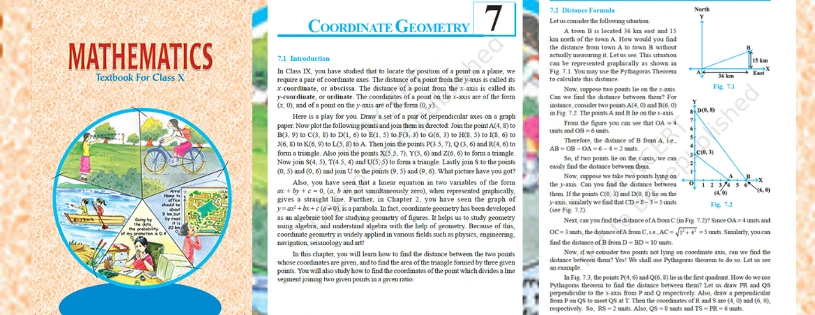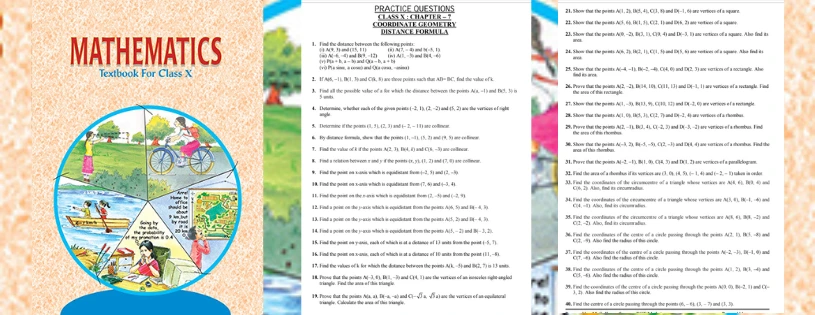In the vast realm of mathematics, coordinate geometry stands as a fundamental and indispensable branch that elegantly marries algebra and geometry. Introduced by René Descartes in the 17th century, this mathematical framework has become a cornerstone in various fields, providing a powerful tool for understanding and analyzing geometric shapes and relationships. In this blog post, we embark on a journey into the captivating world of coordinate geometry, exploring its principles, applications, and significance in both theoretical and practical contexts.
Unlocking Mathematical Marvels A CBSE-NCERT Guide to Coordinate Geometry
The Cartesian Plane
At the heart of coordinate geometry lies the Cartesian plane, a two-dimensional grid that allows us to represent points, lines, curves, and shapes using numerical coordinates. Named after René Descartes, this ingenious system assigns an ordered pair (x, y) to each point in the plane, where 'x' represents the horizontal distance along the x-axis and 'y' represents the vertical distance along the y-axis. The intersection of these axes, often denoted as the origin (0, 0), serves as the reference point for all coordinates.
Points on a Cartesian Plane
A pair of numbers locate points on a plane called the coordinates. The distance of a point from the y-axis is known as abscissa or x-coordinate. The distance of a point from the x-axis is called ordinate or y-coordinate.
Example: Consider a point P(3, 2), where 3 is the abscissa, and 2 is the ordinate. 3 represents the distance of point P from the y-axis, and 2 represents the distance of point P from the x-axis.
Distance Formula
Distance between Two Points on the Same Coordinate Axes
The distance between two points that are on the same axis (x-axis or y-axis) is given by the difference between their ordinates if they are on the y-axis, else by the difference between their abscissa if they are on the x-axis.

Equations of Lines
Coordinate geometry provides a powerful method for expressing and analyzing straight lines using linear equations. The standard form of a linear equation, Ax + By = C, can be transformed into the slope-intercept form, y = mx + b, where 'm' is the slope and 'b' is the y-intercept. Understanding these equations allows us to effortlessly characterize and manipulate lines on the Cartesian plane, unlocking a myriad of geometric insights.
Distance and Midpoint Formulas
The distance between two points in a coordinate plane can be computed using the distance formula: √((x₂ – x₁)² + (y₂ – y₁)². Similarly, the midpoint formula allows us to find the midpoint of a line segment, making these tools invaluable in practical applications such as navigation, physics, and computer graphics.
Conic Sections
Coordinate geometry extends its influence to the study of conic sections—circles, ellipses, hyperbolas, and parabolas. By understanding the algebraic equations governing these curves, mathematicians and scientists can model orbits, analyze reflective properties, and solve complex problems in physics and engineering.
CBSE Class 10 NCERT Mathematics Topics for a Strong Foundation (NCERT DOWNLOAD)
| Chapter Name | Coordinate Geometry |
| Topic Number | Topics |
| 7.1 | Introduction |
| 7.2 | Distance Formula |
| 7.3 | Section Formula |
| 7.4 | Summary |
Transformational Geometry
Coordinate geometry serves as a playground for transformational geometry, where we can explore how shapes change under various transformations such as translation, rotation, reflection, and dilation. These transformations play a crucial role in computer graphics, robotics, and other fields where understanding spatial relationships is essential.
Area from Coordinates
Area of a Triangle given its vertices
If A(x1, y1),B(x2, y2) and C(x3, y3) are the vertices of a Δ ABC, then its area is given by
A = (1/2)[x1(y2 − y3) + x2(y3 − y1) + x3(y1 − y2)]
Where A is the area of the Δ ABC.
Example: Find the area of the triangle ABC whose vertices are A(1, 2), B(4, 2) and C(3, 5).
Solution:
Using the formula given above,
A = (1/2) [x1 (y2 – y3 ) + x2 (y3 – y1 ) + x3(y1 – y2)]
A = (1/2) [1(2 – 5) + 4(5 – 2) + 3(2 – 2)]
A = (1/2) [-3 + 12]
Area = 9/2 square units.
Therefore, the area of a triangle ABC is 9/2 square units.
Collinearity Condition
If three points A, B, and C are collinear and B lies between A and C, then,
-
AB + BC = AC. AB, BC, and AC can be calculated using the distance formula.
-
The ratio in which B divides AC, calculated using the section formula for both the x and y coordinates separately, will be equal.
-
The area of a triangle formed by three collinear points is zero.
CBSE Class 10 Board Exam Sample Paper

[Previous Year Question Solution Maths Download Button]
[Previous Year Question Solution Science Download Button]
| CBSE CLASS 10 Mathematics Chapters |
| Chapter1: Real Numbers |
| Chapter2: Polynomials |
| Chapter3: Pair of Linear Equations in Two Variables |
| Chapter4: Quadratic Equations |
| Chapter5: Arithmetic Progressions |
| Chapter6: Triangles |
| Chapter7: Coordinate Geometry |
| Chapter8: Introduction to Trigonometry |
| Chapter9: Some Applications of Trigonometry |
| Chapter10: Circles |
| Chapter11: Areas Related to Circles |
| Chapter12: Surface Areas and Volumes |
| Chapter13: Statistics |
| Chapter14: Probability |
| CBSE CLASS 10 Science Chapters |
| Chapter1: Chemical Reactions and Equations |
| Chapter2: Acids, Bases and Salts |
| Chapter3: Metals and Non-metals |
| Chapter4: Carbon and its Compounds |
| Chapter5: Life Processes |
| Chapter6: Control and Coordination |
| Chapter7: How do Organisms Reproduce? |
| Chapter8: Heredity |
| Chapter9: Light – Reflection and Refraction |
| Chapter10: The Human Eye and the Colourful World |
| Chapter11: Electricity |
| Chapter12: Magnetic Effects of Electric Current |
| Chapter13: Our Environment |
| Class 8 |
| Class 9 |
| Class 11 |
| Class 12 |
CBSE Class 10th Downloadable Resources:
| 1. CBSE Class 10th Topic Wise Summary | View Page / Download |
| 2. CBSE Class 10th NCERT Books | View Page / Download |
| 3. CBSE Class 10th NCERT Solutions | View Page / Download |
| 4. CBSE Class 10th Exemplar | View Page / Download |
| 5. CBSE Class 10th Previous Year Papers | View Page / Download |
| 6. CBSE Class 10th Sample Papers | View Page / Download |
| 7. CBSE Class 10th Question Bank | View Page / Download |
| 8. CBSE Class 10th Topic Wise Revision Notes | View Page / Download |
| 9. CBSE Class 10th Last Minutes Preparation Resources (LMP) | View Page / Download |
| 10. CBSE Class 10th Best Reference Books | View Page / Download |
| 11. CBSE Class 10th Formula Booklet | View Page / Download |
Being in CBSE class 10th and considering the board examinations you must be needing resources to excel in your examinations. At TestprepKart we take great pride in providing CBSE class 10th all study resources in downloadable form for you to keep you going.
Below is the list of all CBSE class 10th Downloads available on TestprepKart for both Indian and NRI students preparing for CBSE class 10th in UAE, Oman, Qatar, Kuwait & Bahrain.
FAQ
Q1 Why is the Cartesian plane significant in Coordinate Geometry?
Ans The Cartesian plane is the graphical representation of Coordinate Geometry, featuring two perpendicular axes (x and y) intersecting at the origin. It serves as a fundamental tool for plotting points, graphing equations, and visualizing geometric relationships.
Q2 How do you express equations of lines in Coordinate Geometry?
Ans Lines in Coordinate Geometry are typically expressed in the form y = mx + b, where 'm' represents the slope and 'b' is the y-intercept. Understanding this equation allows for easy interpretation of line characteristics on the Cartesian plane.
Q3 What practical applications does Coordinate Geometry have?
Ans Coordinate Geometry finds practical applications in various fields such as physics, engineering, computer science, and geography. It is used to model and analyze real-world phenomena, including navigation, computer graphics, and the study of conic sections.
Q4 Can Coordinate Geometry be challenging for students?
Ans While Coordinate Geometry may initially seem challenging, practice and a solid understanding of foundational concepts can make it more accessible. CBSE-NCERT curriculum provides a structured approach to learning, ensuring students gradually master this mathematical discipline.
Q5 How does Coordinate Geometry contribute to problem-solving skills?
Ans Coordinate Geometry enhances problem-solving skills by providing a systematic approach to analyzing geometric relationships and equations. It encourages logical thinking and the application of mathematical principles to real-world scenarios.
Leave a Reply